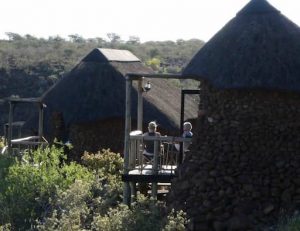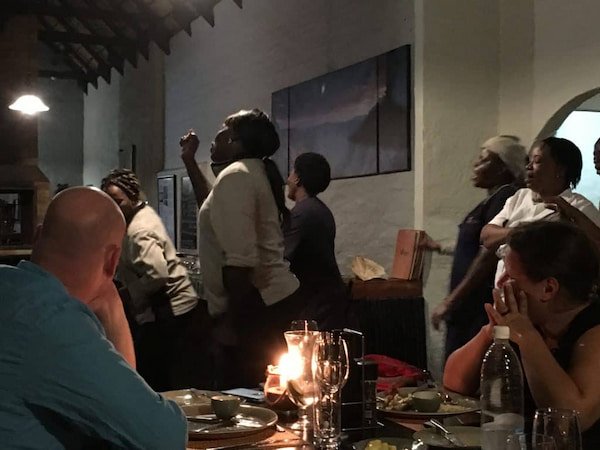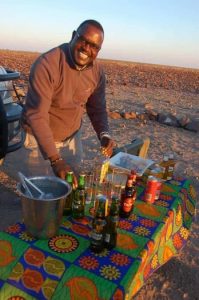Destination Stewardship Report – Winter 2021 (Volume 1, Issue 3)
This post is from the Destination Stewardship Report (Winter 2021, Volume 1, Issue 3), an e-quarterly publication that provides practical information and insights useful to anyone whose work or interests involve improving destination stewardship in a post-pandemic world.
Namibia’s award-winning ≠Khoadi-//Hôas conservancy has often been cited as a success story in both conservation and community benefit. Destination Stewardship Report editor Jonathan Tourtellot takes a tourist-eye view of this community-run destination – part of our ongoing project to profile places with an effective method for holistic management in the spirit of GSTC’s Destination Criterion A1. This is the fifth in a series being assembled by the Destination Stewardship Center.
A Tourist Visits a Model Destination Stewardship Conservancy
By Jonathan Tourtellot

Klip River Valley, #Khoadi-//Hoas conservancy, Namibia. All photos by Jonathan Tourtellot.
19 May 2019 – It has taken 10 hours for our van to drive north and then west from Windhoek, first on excellent paved highways, then on broad gravel roads. As daylight fades, we pass a nondescript sign reading ≠KHOADI-//HÔAS CONSERVANCY. (The unusual characters represent different clicks in the local Damara language.)
A long drive up a mountain ridge and into growing darkness brings us to Grootberg Pass, elevation 1,540 meters, and a rustic parking area. Eventually a LandCruiser appears. It takes us grinding up a steep rocky track that would challenge a mule. We crest a rise, and behold, fairylandlike, the lights of the Grootberg Lodge.
Reputed to be one of the best in Namibia, the ≠Khoadi-//Hôas conservancy (pdf) is a repeat winner of destination accolades, including placement in the Sustainable Destinations Top 100. The conservancy constitution describes its mission: “To provide an incentive to rural people to conserve wildlife and other natural resources through shared decision-making and financial benefit.”
The community owns and helps run the Grootberg Lodge. In a normal year, wildlife tourism is the conservancy’s prime tourism moneymaker, at more than 75% of community revenue. Unlike many tourist accommodations among Namibia’s 86 conservancies operated on a joint venture agreement, Grootberg Lodge is 100% owned by the conservancy, and a contracted management company manages the Lodge on behalf of the conservancy community.
With about one person for each of its 3,300 square kilometers, the conservancy is roomy – larger than Luxembourg or the U.S. state of Rhode Island. The land is divided into various areas dedicated to settlement, agriculture, wildlife tourism (Grootberg and surrounds), and wildlife hunting, or combinations of these.
The staff treats us to a welcome drink on a deck that seems to hang over an inky abyss. We dine and retire, taken by guides with flashlights each to our own thatched bungalow.
Next morning, the seeming abyss reveals itself: The dramatic Klip River valley, scooped out of a semiarid plateau landscape. Its cliffs and mesas are painted in morning pastels, inviting exploration. The lodge was sited way up here for good reason.
Context: How It Began, and Why

Grootberg Lodge guest bungalows, made from local materials.
Led by the local Grootberg Farmers Union – itself formed in 1990 – ≠Khoadi-//Hôas formed in 1998 as part of Namibia’s program to help communal area residents benefit from wildlife and tourism by forming conservancies. With foreign assistance, the Grootberg Lodge was built soon thereafter, opening in 2005. It was Namibia’s first lodge to be fully owned by the community. The conservancy constitution describes the purpose: “To link conservation with rural development by enabling communal farmers to derive a direct financial income from the sustainable use of wildlife and tourism.”
Governance: Who’s in Charge?
A Management Committee elected by community members oversees tourism activities throughout the conservancy, along with ecological issues and wildlife management. Of the 3,500 or so conservancy residents 2,500 are voting members. Membership eligibility requires a minimum age of 18 and at least two years in residence. Management Committee members serve 5-year terms, limited to two consecutive terms. An Executive Committee handles day-to-day decisions, with the “Traditional Authority”– ethnic chiefs and their staffs – advising.
Not all Namibian conservancies are so well run, and some have fallen prey to corruption. By contrast, ≠Khoadi-//Hôas is consistently ranked one of the best managed. Why? “Total transparency, no matter how bad the situation might be,” says conservancy Manager Lorna Dax. Everything is audited, and the reports are public. In general, the conservancy strives to adhere to the central government’s five conditions for good conservancy governance:
- Hold Annual General Meetings.
- Properly elect the Conservancy Management Committee.
- Produce annual financial statements.
- Disburse as per the Benefit Distribution Plan.
- Manage wildlife according to a game usage plan, reporting annually.
The Management Committee works with the Namibian Ministry of Environment, Forestry, and Tourism and several NGOs, including the World Wide Fund for Nature, the Grootberg Farmers Union, the Namibia Association of CBNRM Support Organization, and others. The conservancy contracts with Journeys Namibia to run and market the Grootberg Lodge, but most of the staff is local, including assistant managers.
Many of the carefully trained staff and guides are from the local community. I might imagine it, but I detect a distinct sense of pride and ownership in their bearing and attitude. They don’t manage the lodge yet – that still falls to the joint-venture management company, Journeys Namibia – but one guide told me he thinks they are ready to take over in a year or two. Maybe so.
Funding: Who Pays?
In comparison to other, still somewhat impoverished rural areas, management reports funding as adequate. Community residents each receive benefits from the lodge, a campground, and a newly acquired smaller lodge, channeled through the conservancy.
According to Manager Dax, the conservancy during a normal year does not get financial support from the government or NGOs, mostly just technical support and a bit of funding to compensate farmers that lose livestock through human-wildlife conflict. “During the Covid-19 pandemic,” she adds, “we have relied heavily on the grants from the government’s Covid relief fund, which help us to cover operational costs and natural resource management. Without these grants most of the conservancies would have closed their doors by now.”
How Conservation Works

Zebras browse the conservancy’s rocky Etendeka Plateau.
Among local wildlife, the conservancy website lists “desert-adapted elephant, black rhino, giraffe, mountain zebra, eland, kudu, gemsbok, black-faced impala, springbok, duiker, steenbok, klipspringer, warthog, ostrich and baboon. Predators include lion, leopard, cheetah, jackal, spotted and brown hyaena.”
Different areas of the conservancy are set aside for wildlife watching, local hunting, and tourist trophy hunting. (A 2020 podcast discusses that last controversial activity from the African point of view.)
Eight “Environmental Shepherds” hired by the conservancy act as game rangers and ecological watchdogs, overseen by a Co-ordinator who is also employed by the conservancy. The shepherds ensure that any hunting is legal and any claims for livestock losses to predators are legitimate. Payment for livestock loss through predation is based on on-site inspection of the carcass.
My wife, Sally, signed up for a 6-hour rhino tracking excursion. “It was not just a tour,” she told me on her return, looking suitably trail-weary. “They were really tracking an animal. I’ve never experienced anything like that. This was not easy! We spent hours trying to find a rhinoceros.” Then she described something you cannot do in a national park. “When the trackers finally spotted one, we left the Land Cruiser and went scrambling over rocks to finally see it. A young male, suspicious but patient enough to let us look at it.” In the parks, tourists must generally stay in the vehicles.
Land Use
Community-endorsed zonation delineates areas dedicated to settlement, agriculture, livestock grazing, wildlife tourism (where we were), and wildlife hunting, or combinations of these.
This arrangement works only as long as it works. When I asked what would happen if a mining company showed up with an attractive offer in exchange for starting a mining operation with concomitant pollution, the answer came back, “The community would probably go for it, but all required channels should be followed and all stakeholders involved.”
Community Engagement
The Lodge gives preference to residents for buying local firewood, vegetables, etc. In addition to electing the Management Committee, residents have priority in applying for Lodge & campground job openings. Conservancy members also participate in game counts for conservation management, and attend an Annual General Meeting to participate in the conservancy’s decision-making process. The conservancy, for instance, uses earnings from the lodge for such things as stationery and supplies for schools, community projects, scholarships, soccer tournaments, and funeral assistance.
Time for the sundowner.
We take a sunset game drive around the Etendeka Plateau behind the Lodge, a barren-looking tableland strewn with red rocks that nevertheless supports a variety of wildlife. We see lots of zebra, an oryx, and a lone jackal. And then, of course, comes the customary gin-and-tonic sundowner.
At dinner, Sally mentions her discomfort with enjoying our first-world affluence amid the hard-scrabble reality of rural life in Namibia: “I feel guilty.” I can only point out that we are paying fair prices to a business that earns money for the community and incentivizes wildlife protection, including that rhino. In that sense, we are a useful part of the ecosystem.
After dinner, a surprise. The staff and kitchen crew come out and perform songs and a couple of dance routines. They’re good at it, a product of the enthusiastic singing competitions organized among the staffs of Namibia’s various joint-venture conservatories. Post-dinner singing has become a custom – and a lagniappe for guests. How often do you get serenaded by your chef?

Diners watch after-dinner singing at Grootberg Lodge.
The Measures of Success
The metrics for evaluating progress are simple: tourism revenues and game counts. If both are steady or increasing, that’s a good sign, provided the revenues are distributed fairly and species of game don’t exceed sustainable levels.
≠Khoadi-//Hôas in the Time of Covid
With the Grootberg Lodge being heavily dependent on long-haul tourism, the pandemic of 2020 brought a severe test to ≠Khoadi-//Hôas. “As most if not all conservancies in Namibia depend on tourism and conservation hunting as the only source of income, their operations were crippled by the sudden outbreak of Covid-19. The conservancy had to stop all benefits going to the community, as there was no income,” reports Manager Dax. “Regular meetings could not be held due to restrictions imposed by the government, and this caused uncertainty among community members. Staff at the lodges were sent home with salary cuts, and poverty increased in the conservancy area.”
In Africa’s conservancies, that’s apparently what happens when tourism goes away.
Commentary
Despite its vulnerability to a sudden tourism drop-off, the ≠Khoadi-//Hôas model is one of the best anywhere in our “A1” search for destinations that come close to meeting the GSTC’s Criterion A1 for holistic destination management. “KH” has good community benefit and participation, good conservation of natural resources, appropriate land use, and at least some cultural benefit.
But this model is most likely limited to places with community-held land, or with land held in trust for the community (as in Namibia), or with what could be called a “commons ethic,” a cultural predisposition to see land as a communal asset rather than in terms of transactional ownership. It’s hard, for instance, to picture a collection of cantankerous, U.S.-style individual landowners all agreeing to the communitarian structure. The existence of the Grootberg Farmers Union also helped prepare the ground, setting a community precedent for a cooperative undertaking. Destinations with thriving producer cooperatives might consider building on that approach.
All that said, the democratic Conservancy Management Committee approach is one that could well be adapted to smaller destinations anywhere, as it marries tourism management with community benefit and conservation of destination assets – mainly wildlife, in this case.
If other conservancies in Africa and elsewhere can begin measuring up to the same standard, this seems like one of the best possible ways to combine conservation with benefits to local people, funded by responsible tourism. Enlightened leadership and “total transparency” seem to be keystones of success.
On the morning of our third day, we bid a reluctant goodbye to the enthusiastic staff of the Grootberg Lodge and descend their improbably steep access track down to the parking area, where we clamber back into the van and wind our way off into the flatlands and famed Etosha National Park. There I would see a difference: Etosha would offer many wonderful moments, and the lodge employees, working for a national park management company, were capable enough, but they acted like, well, employees. It wasn’t Grootberg.
~ ~ ~
Thanks to Martha Mulokoshi and Omagano Shooya for assistance with this report. Portions of my visiting-tourist account previously appeared in the former National Geographic Open Explorers platform.
About the Author
Jonathan Tourtellot, CEO, Destination Stewardship Center; Editor, Destination Stewardship Report; Principal, Focus on Places LLC; founding Director, former Nat Geo Center for Sustainable Destinations




